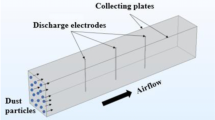Abstract
In this paper, a laboratory-scale model for prediction of the voltage–current (V–I) characteristics of wire–plate electrostatic precipitators (ESPs) under clean air conditions is presented and experimentally validated. The model investigates the effect of electrode configurations, wire diameter, spacing between wire electrodes, number of discharge wires and distance between collecting plates that on V–I characteristic of wire–plate ESPs. Also, this paper presents a simulation model, based on the finite difference method, to simulate electric conditions of wire–plate ESPs under clean air conditions. The experimental results of some models are compared with those obtained from the simulation models.

Similar content being viewed by others
References
Rajanikanth B.S., Jayan M.V.: Simulation of dust loaded V–I characteristics of a commercial thermal power plant precipitator. IEEE Trans. Dielectr. Electr. Insul. 17(1), 39–44 (2010)
Ziedan, H.; Tlustý, J.; Syed, A.; Mizuno, A.; Ahmed, A.: Onset voltage of corona in wire-duct ESP’s as influenced by precipitator geometry. In: 5th international Scientific Symposium, Electroenergetika, pp. 23–25. Stara Lesna, Slovakia (2009)
Ziedan H., Sayed A., Mizuno A., Ahmed A.: Onset voltage of corona discharge in wire-duct electrostatic precipitators. IJPEST Int. J. Plasma Environ. Sci. Technol. 4(1), 36–44 (2010)
McDonald R., Anderson H., Mosley B., Sparks E.: Charge measurements on individual particles exiting laboratory precipitators with positive and negative corona at various temperatures. J. Appl. Phys. 51(7), 3632–3643 (1980)
Parker, K.: Electrical operation of electrostatic precipitators. In: IET Power and Energy Series, vol. 41, London (2007)
Abdel-Salam, M.; Eid, A.: Finite element simulation of corona in wire-duct precipitators. In: Industry applications conference, 2002. 37th IAS annual meeting. conference record of the, pp. 1383–1389
Lei, H.: Charge-current-conservation model for calculating electrical conditions in a wire-plate electrostatic precipitator. IEEE Trans. Dielectr. Electr. Insul. 13(4), 795–802 (2006)
Rajanikanth B.S., Thirumaran N.: Prediction of pre-breakdown V–I characteristics of an electrostatic precipitator using a combined boundary element-finite difference approach. Fuel Process. Technol. 76, 159–186 (2002)
Lei H., Wang L.-Z., Wu Z.-N.: Applications of upwind and downwind schemes for calculating electrical conditions in a wire–plate electrostatic precipitator. J. Comput. Phys. 193, 697–707 (2004)
McDonald, J.R.; Smith, W.B.; Spencer, H.W.: A mathematical model for calculating electrical conditions in wire-duct electrostatic precipitation devices. J. Appl. Phys. 48(6), 2231–2243 (1977)
Rajanikanth B.S., Sarma D.V.S.: Modeling the pre-breakdown V–I characteristics of an electrostatic precipitator. IEEE Trans. Dielectr. Electr. Insul. 9(1), 130–139 (2002)
Author information
Authors and Affiliations
Corresponding author
Rights and permissions
About this article
Cite this article
El Dein, A.Z., Usama, K. Experimental and Simulation Study of V–I Characteristics of Wire–Plate Electrostatic Precipitators Under Clean Air Conditions. Arab J Sci Eng 39, 4037–4045 (2014). https://doi.org/10.1007/s13369-014-1046-2
Received:
Accepted:
Published:
Issue Date:
DOI: https://doi.org/10.1007/s13369-014-1046-2




